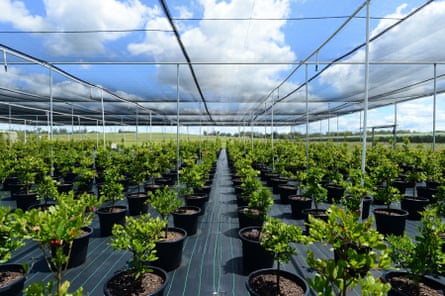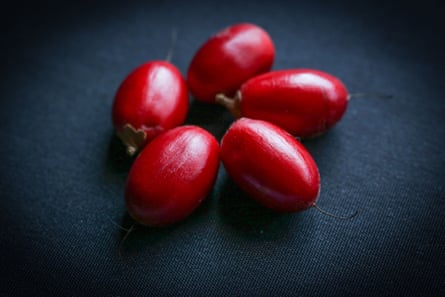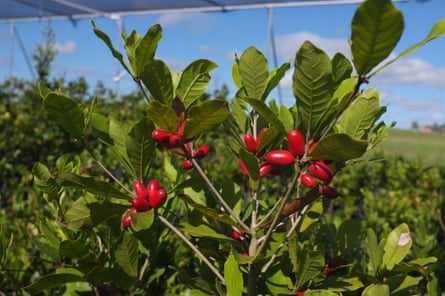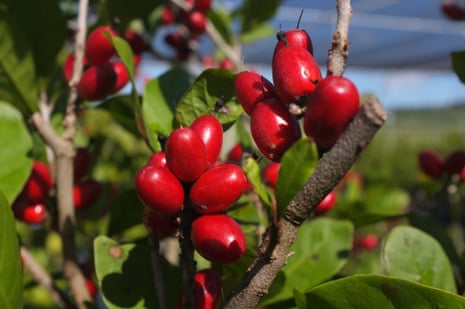Don Anderson describes himself as “a sceptic” but, four years ago, when he lost his sense of taste while undergoing radium therapy for prostate cancer, Anderson turned to an unorthodox treatment for relief.
“Yeah, I was doubtful,” the retired fisherman and boat skipper from Port Douglas says. “But I was also pretty fed up with everything tasting totally bland, so I thought I’d give it a go. I had nothing to lose.”
What Anderson tried was the fruit of Synsepalum dulcificum, known colloquially as “miracle fruit” or “miracle berry” – not for its health qualities but its impact on people’s tastebuds.
The bush, which originates in central and west Africa, made its way to sub-tropical Queensland in the late 1970s, and was primarily known for its novelty value.
Eating the berries results in a protein being attached to the tongue which makes sour foods taste unusually sweet for short periods. Queenslanders with a bush in their back yard would hold miracle berry parties, consuming the berry before experimenting with a variety of sour foods.
But for Anderson, the berries supplied sweet relief.
“I was pretty happy … it got my appetite back, and let me enjoy food again,” Anderson says.
From mangosteens to ‘miracles’
Keen to escape the frenetic pace of life in Sydney, Chris Beckwith and Karen Pereira, a former film company owner and advertising production manager respectively, moved north to the Daintree in 2013, where they took up farming mangosteens. Fate was going to alter their course, however.

“When we set up the Daintree farm we were given a small miracle fruit tree,” Beckwith says. “We were amazed how lemons, tomatoes, passionfruit and all acidic fruits tasted incredibly sweet after sucking a berry.
“Then one of our friends told us how the berries were being used by people who were experiencing taste issues from their cancer treatment – that the berries could mask the bad taste, allowing them to eat and gain nutrition to fight their cancer,” Beckwith says.
The couple cryovaced some of their berries and sent them to a friend in Sydney, who was experiencing a metallic taste in his mouth during treatment for leukaemia.
“His only relief was to suck ice cubes,” Beckwith says. “So he was excited when he tried the berries and found he could taste again. It allowed him to experience a better quality of life until he passed.”
Fascinated by the potential it offered, the couple planted 3,000 trees in pots, attempting to become Australia’s first commercial grower. But finding the long tropical downpours not conducive to growing on a commercial scale moved their fledgling business south to Childers, near Bundaberg in 2021.

While waiting for their plants to produce in a quantity to make a mass harvest viable, Pereira and Beckwith are importing the fruit in freeze-dried cubes from a farm in Florida, distributing it to pharmacies and cancer treatments clinics.
The miraculin switch
So what is it in miracle berry that can change human taste receptors and what are implications for its use?
“It’s a single glycoprotein protein identified in the fruit called ‘miraculin’,” says Dr Nenad Naumovski, associate professor in food science and human nutrition at the school of rehabilitation and exercise sciences at University of Canberra.
“Once bound to the tongue, it remains relatively non-active, however if the acidity increases (such as with the intake of lemon juice) it activates the sweet sensation, ‘tricking’ the consumer to [experience] a sweet taste.”

While the taste-altering effects of miraculin are well documented, there are still limited well conducted studies into its use as an aid in one of the side effects of cancer treatment, dysgeusia – the alteration of taste.
In 2012, a pilot study on the use of miracle fruit to improve food palatability for eight patients receiving chemotherapy in The Journal of Oncology Nursing reported that “all study participants reported positive taste changes with the supplement”.
Meanwhile, in May, a study kicked off at the University of California Health into the impact of miraculin on taste dysfunction in head and neck cancer patients receiving radiation therapy.
Researcher Dr Jessica Chew said while they had found two small but promising studies into the benefits of miracle fruit in patients receiving chemotherapy, there were none on patients receiving radiation therapy. “Taste dysfunction continues to be a side-effect that is very difficult to address,” she said.
In Burnie in Tasmania, North West Cancer Centre senior dietitian Lee-Anne Mundy recommends the fruit to her oncology patients who are dealing with dysgeusia.
“It doesn’t work for everyone – cancers are different, patient symptoms are different, areas targeted are different,” she says.
The dysfunction in chemosensors relating to smell and taste is also often reported as one of the prognostic symptoms associated with Covid-19, and particularly long Covid.
Naumovski said research in this area was still lacking, but said it would be useful to study use of miracle fruit and whether it could help those with Covid whose sense of smell and taste has been affected. He stressed they would not cure the problem but may assist with the management of symptoms.

Being pioneers in growing this unusual crop has not been easy, Beckwith and Pereira admit.
“Looking back, if we knew all the hurdles in our path it would have been quite daunting,” Pereira says.
They expect to have their trees ready for commercial harvest within two years, and for the meantime are researching as much as possible.
“We are still at the R&D stage. We ask a lot of questions, sometimes too many, and I Google and read like crazy because there are people depending on us.”
